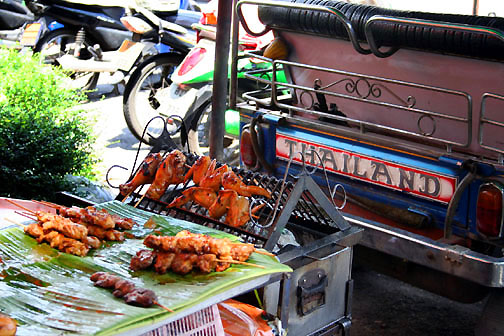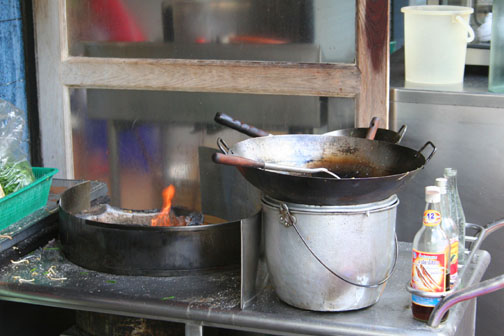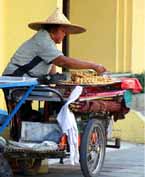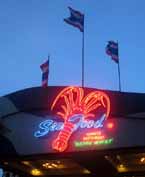
Tuk tuks and street food make pictures of Bangkok instantly recognizable. If you are smart, you’ll avoid the former, and enjoy the latter.
There are approximately 38,000 street food vendors in Bangkok. Slightly more than half of them operate legally with a permit. The 2,000 baht fine for an illegal stall is worth the risk for the rest, and the matter can probably be taken care of with a free meal and a little bit of tea money anyway. Whether the vendor coughs up with the 300 baht per square meter cleaning fee charged to stalls with a permit, or coughs up the appropriate bribe instead, with an estimated 54.75 billion baht spent on street food in Thailand annually, it’s not surprising that so many streets are lined with vendors busy tending their cooking fires.
From small mobile units the size of a hot dog cart to almost permanent affairs sporting long communal tables with seating for a few dozen, and everything in between, street food businesses are an integral part of city life in Bangkok. 80% of the city’s residents eat street food more often that from fast food places, food courts, and restaurants. Street food is the primary source for meals for many of them. And touri who smart will follow their example. Dining on Bangkok’s streets is one of the most enjoyable experiences for any holiday in Thailand. The only danger is you may come home ten pounds heavier than when you flew out.
The paradox of those who epitomize Cheap Charlies, refusing to spend more than 800 baht a night on hotels and moaning about the cost out for a night of fun on Soi Twilight, are often the same who turn their noses up at the thought of dining out on Bangkok’s streets is amusing. For a fraction of the price you’d be charged at even a bare-bones Thai restaurant in the city, you can have a freshly prepared meal served up curbside instead. Granted, some touri have pussy stomachs. But more often it is the concern over eating improperly prepared or stored food than the actual experience that keeps them from enjoying a gastronomical feast.

When freshly cooked and eaten hot, street food is perfectly safe for most visitors despite how unhygienic the cooking facilities may look.
Most food stalls in Bangkok are perfectly safe to eat at for two reasons. First, killing off or making your customers ill is not the way to attract repeat business. Most food vendors rely on a steady trade of return customers and take a lot of pride in the dish, or dishes, they offer. Second, regardless of the money to be made selling food along Bangkok’s streets, the 20,000 fine – and possible jail time – levied for selling contaminated food is a strong deterrent against offering up yesterday’s chicken.
Passing up the opportunity to try some of the city’s most tempting food out of concern of losing a few days of your visit to illness is a grave error. It is something you need to do as a touri. If nothing else think of it as revenge for everything else those bustling streets throw your way. Take a few simple precautions – and note where the closest pharmacy is to your hotel just in case – and your trip can be that much more of an experience by trying out some of the mouth watering food you’ll be walking past during both the day and night.
Your best bet for once is to let your inner lemming free and follow the crowds. There’s a reason one stall grabs a lot of business and another doesn’t. The locals know who has the best food; join the biggest mob (that’s what Thais call a line) and get ready for pure heaven. Most of the more popular street food vendors offer a single dish. That signature dish is their bread and butter and they cook it to perfection. Those that offer a smorgasbord of dishes are generally not as good. Besides, wandering from one stall to the next is one of the best ways to pass through Bangkok’s streets.
Part of what makes the food from street vendors so yummy is its freshness. It’s a direct route from the cooking pan to your stomach. And it was probably even a more direct route from the farm to the food stall – most of what you see being cooked at Bangkok’s food stalls was clucking, mooing, or swimming that morning. Still, if you are concerned about picking up a nasty bug you’re better off only eating that which has just been cooked. So don’t accept something that has been sitting there for awhile. Vendors seldom get upset at those who want freshly cooked food – just point at the raw ingredients and they will catch your drift and whip up your meal fresh.
Cleanliness is next to godliness, but the god worshiped in Bangkok is not one you are familiar with, so adjust your hygiene expectations a bit too. That doesn’t mean you should throw caution to the wind. Stacks of dirty dishes next to a stall is never a good sign, nor are dirty trays holding the food that was just cooked or is ready for cooking. But don’t expect the cooks to be wearing plastic gloves either.
What to eat is always the big question. Half of what is available at food stalls won’t look in the least bit familiar. And the other half all looks so good you can easily starve wandering from stall to stall trying to decide what to try first. Seafood and shellfish can be the most risky and if that’s your desire the stalls in Chinatown are renowned for having the best and freshest seafood in the city. Otherwise just dig in. But don’t wuss out and try to order your meal less spicy. Spices have been used for centuries in countries like Thailand to kill germs and bacteria in food. The essential oils in the spices are antibacterial and are miraculous against things like E. coli and Salmonella, so you are better off not asking that your food be dumbed down for the touri palate – the vendor will already ease up on the hot chilies just from looking at your pasty white face.
In areas heavily visited by tourists, it is even more important to take your cue from the locals. Not because of food safety but rather quality of the food offered. Food vendors who cater to the touri crowd do not need to be as particular about what they are serving; there’s a big difference between the Pad Thai you buy on Khaosan Road and what you’ll get just a few blocks away.
A visit to the Big Mango means savoring all of the delights the city has to offer. The magnificent dishes prepared by streetside vendors are a must-do part of the Thailand experience. Lunch, or dinner, for a buck is hard to pass up and after trying a few of the different dishes available on every corner, you’ll be hooked. But you may want to work your way up to the fried insects.
Related Posts You Might Enjoy:







I am in Bkk now and reading your post whilst waiting for the storm to pass over!
I often eat from street vendors but have never touched the salads…. I was just wondering whether, in your experience lettuce, tomatoes etc are safe to eat from street vendors?
You mean besides that a salad of lettuce and tomatoes is boring?
🙂
Cooked is always the better way to go John. Lettuce may have been washed in water that your stomach may not aprove of – but fruit is generally safe.
Stay dry
I’ve eaten, on and off, from stalls for years. But, people who would like to try street food that has higher hygiene standards should consider the food courts at major old style department stores. I recall one at Central on Silom and one at MBK that had everything – no one but Thais there and very clean.
Thanks Don – That’s a great tip, the food courts geared toward the local crowd are pretty close to food cart dining. And are a great deal too. They seem to be a required feature at all malls these days, but I think MBK’s is still the best of the lot for local-style dining.
Hey! You forgot to mention the fried silkworms! They’re absolutely yummy!
My friends in Chiang Mai make me eat things I prefer not to know the name of….
and which I find delicious. And the doctor at the travel clinic where I check my vaccines every year, told me : as long as it’s warm and cooked…. but be careful with seafood ! Touch wood, never had a problem……yet !
Smart. There are dishes I still don’t have a clue about, but I recognize and order them because they are so good.
Your thoughts about Thai law enforcement, as per paragraph one, are simply amusing, but that aside, this is a great post! 🙂
I just came back home and I have to work tomorrow. That sucks even more than running one of these stalls without any permit, let me tell you that. 😉
Huh.
“Thai law enforcement”
I don’t think I’ve ever seen that phrase before.
🙂
In general I am not that picky what I put in my mouth (any dick will do), but with street food I have an issue. It is not the food itself, which as you mention also, is always fresh and freshly made. It is the way they clean the dishes and eating utensils, they just rinse it in some bucket with disgusting brown water, never saw that bucket got cleaned. For that reason I never ate street food, though it is very tempting.
That disgusting brown water is what gives the food its flavor!
Someone told me that is actually tea, which is supposed to be a good cleanser.
But if you are gonna eat on the streets you do have to put some of your normal requirements for cleanliness aside.
The food is worth it.
I buy the food back to my hotel room to eat so I never worry about the plates and cutlery, otherwise I just go for anything that’s grilled on a stick though even that I prefer to eat in the privacy of my room – I’ve been told that the way I eat stick snacks could get me arrested. And also that it shows how much practice I’ve had stuffing boy sausage in my mouth.
But you could be quite popular over on soi 4!
Huh? Why Soi 4? I’m not that familiar with the entertainment establishments there.
Non-gogo bar world – just thought your talents on display might arouse some interest.
Have quite the cast-iron stomach so I brave the stalls all the time 🙂 Love picking up snacks on the road.
As long as it is not picking up snacks off the road you’re doing fine Paul.